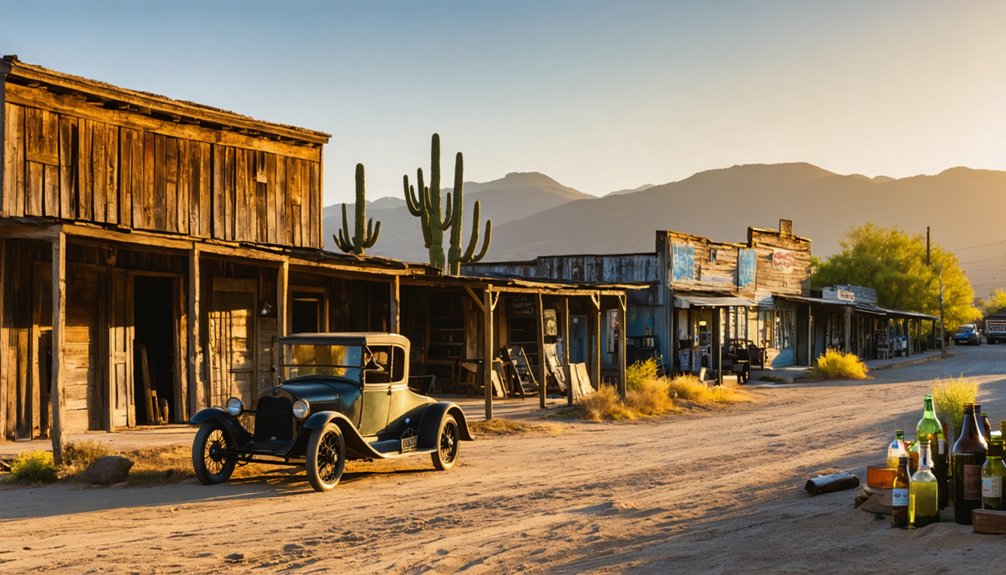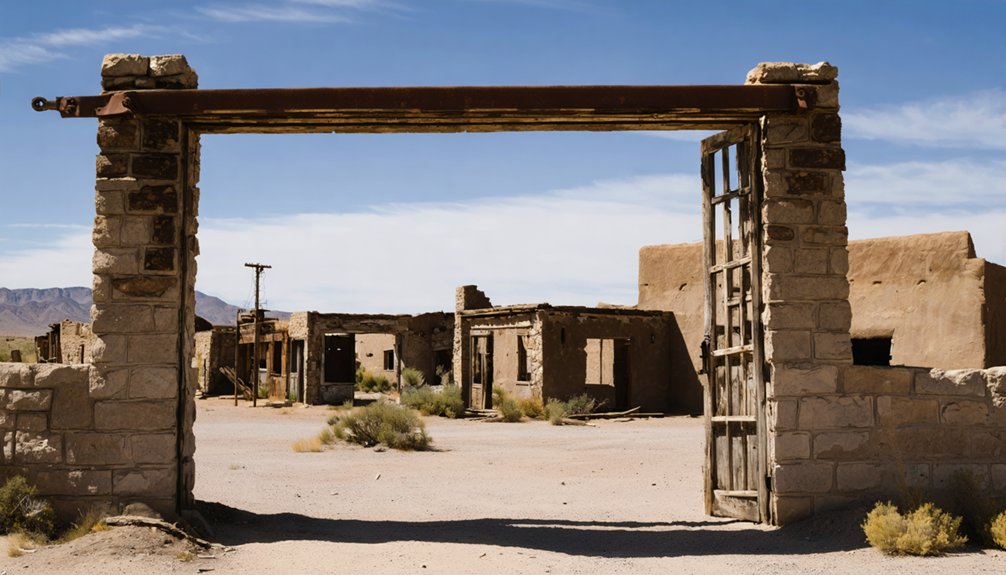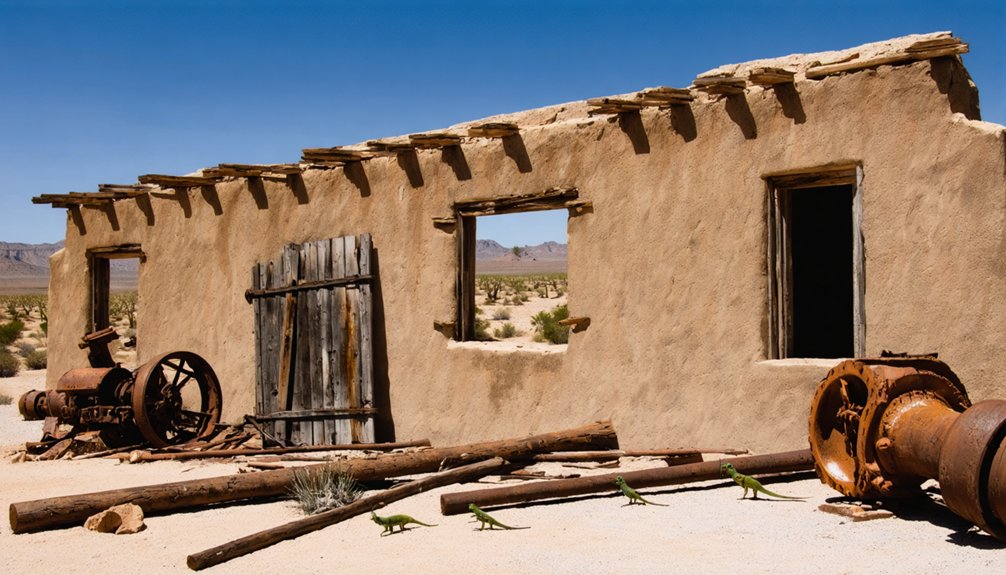Swansea, Arizona, offers you a remarkably preserved copper mining ghost town dating back to 1909. Named after its Welsh counterpart, this remote desert outpost once housed 750 residents before its 1924 abandonment. You’ll discover adobe foundations, smelter ruins, and rusted equipment along the BLM’s interpretive trail. High-clearance vehicles are needed to navigate the rough 30-mile journey southeast of Parker. The crumbling structures whisper stories of Welsh mining traditions that shaped this forgotten frontier.
Key Takeaways
- Swansea is an abandoned copper mining town in western Arizona established around 1909, named after the Welsh city with metallurgical connections.
- The ghost town extracted 27 million pounds of copper before declining, with its population peaking at 750 residents between 1909-1924.
- Visitors can explore ruins including smelter remains, adobe foundations, and mining equipment via the BLM’s interpretive trail.
- Located 30 miles southeast of Parker, accessing the remote site requires high-clearance vehicles and careful preparation.
- The BLM manages preservation efforts including stabilizing historic structures and securing hazardous mine openings while allowing public access.
The Desert Town That Time Forgot
Nestled in the unforgiving Arizona desert, Swansea stands as a silent sentinel to America’s mining heritage.
You’re looking at a town that wasn’t always called Swansea—it began as “Signal” before being renamed to reflect its international copper connection with Swansea, Wales, where much of its ore was shipped for processing.
Founded around 1909, though prospectors had been eyeing the area since the 1860s, this copper mining town faced immense mining challenges from the start.
Born in 1909 on land coveted since the 1860s, Swansea battled the desert’s harsh realities from its first breath.
Despite building an impressive 350-ton furnace, multiple mine shafts, and even piping water from half a mile away, financial troubles began by 1911.
The town’s historical significance lies in its well-preserved ruins—a rare glimpse into the boom-and-bust cycle that defined the American West’s frontier spirit.
At its peak, Swansea boasted a population of about 500 residents with amenities including an electric light company, theater, restaurant, and barber shop.
The mining operations extracted an impressive 27 million pounds of copper during their active years, leaving behind a significant historical footprint in the area.
Journey to a Remote Arizona Mining Outpost
The rugged journey to Swansea mirrors the tenacity of those who first established this remote mining outpost. You’ll navigate the same harsh desert landscape early miners confronted when they arrived in 1862, facing accessibility challenges that delayed serious development until the Arizona and California Railroad’s arrival in 1904.
Today, you’ll travel rough dirt roads to reach this preserved slice of ghost town history, far from paved thoroughfares north of Bouse and east of Parker. This isolation—while creating mining challenges for early operators—has ironically protected Swansea’s remaining structures from vandalism. The area was initially named Signal before being renamed Swansea in 1909.
The half-mile water pipeline from Bill Williams River, the massive 700-ton smelter, and the 1917 worker cottages stand as evidence of human determination. The town’s population reached its peak of 750 residents during the height of mining operations. Despite electric lighting and railroad access, Swansea’s remoteness defined its character—just as it will define your adventure.
From Boom to Bust: The Copper Legacy
As you stand amid the ruins, you’ll notice the distinctive Welsh influence that gave Swansea its name and smelting expertise—a heritage connection to South Wales that shaped this desert outpost’s identity.
Your eyes can’t miss the remnants of the 700-ton smelter that once produced copper at a rate of 50 tons daily, transforming this barren landscape into an industrial powerhouse worth millions before economic realities set in.
Located in La Paz County, the Swansea Mine was primarily known for its copper production with secondary commodities including gold, iron, and silver.
The weathered foundations and crumbling structures tell the story of copper’s fleeting promise, where 27 million pounds of extracted ore couldn’t prevent the inevitable abandonment by 1937, leaving only rusty machinery and hollow buildings as evidence of humanity’s brief industrial triumph against the desert’s permanence.
Today, visitors can explore the site under the management of the Bureau of Land Management, which has worked to preserve this fascinating piece of Arizona mining history.
Welsh Mining Heritage
Named after its Welsh counterpart across the Atlantic, Swansea, Arizona forged a mining identity deeply rooted in Celtic metallurgical expertise.
The town’s cultural heritage sprang from the first ore shipments sent to Wales for processing using the revolutionary “Welsh Process” of copper smelting.
When you explore Swansea’s mining techniques, you’ll discover four key elements that defined the Welsh influence:
- Hand-sorting of ore by skilled workers
- Multiple calcining steps to remove sulfur
- Smelting with specific fluxes for peak extraction
- Poling with green wood to produce tough pitch copper
This Welsh connection wasn’t coincidental—George Mitchell, the mining company’s financial backbone, hailed from Swansea, Wales himself, cementing the bond between these distant lands united by copper’s reddish glow. The construction of a 350-ton capacity furnace in 1908 marked a significant investment in bringing Welsh smelting methods directly to Arizona soil. The process remained largely unchanged until Bessemer’s invention of the blast furnace revolutionized copper production in the mid-19th century.
Industrial Rise and Fall
While Welsh miners bestowed Swansea with its metallurgical foundations, railroad steel ultimately determined the town’s fortunes. The 1904 arrival of the Arizona & California Railroad transformed limited mining claims into an industrial powerhouse, releasing Swansea’s copper extraction potential from the harsh desert landscape.
You’ll find the story of America’s industrial ambition etched into these ruins. By 1910, Mitchell’s smelters roared to life, employing advanced smelting techniques that produced 50 tons of copper matte daily, generating $15,000 in revenue. This success reflected Arizona’s broader mining infrastructure development that saw over 400,000 claims statewide. The completion of the Southern Pacific Railroad in 1876 had already made copper mining economically viable throughout Arizona territories.
Between 1906-1949, miners extracted 27 million pounds of copper from these hills.
Yet freedom from economic cycles proved elusive. World War I’s conclusion, coupled with the Great Depression, gradually silenced the furnaces.
Scars on Desert Landscape
Four enduring environmental wounds mark Swansea’s copper legacy, visible scars that tell the story of mankind’s industrial ambitions colliding with desert ecology.
As you wander these forsaken grounds, you’re witnessing the stark aftermath of extractive industry.
The mining impact remains etched into this landscape through:
- Massive open pits where mountains once stood, now permanent alterations to the natural skyline
- Tailings piles containing toxic residues that harden washes and resist nature’s reclamation
- Contaminated waterways, including nearby creeks deemed impaired from a century of industrial activity
- Depleted aquifers that may never recover, having been drained to quench copper production’s thirst
These environmental scars aren’t merely historical footnotes—they’re warnings of what unfettered industrial ambition costs the land.
Life in Early 20th Century Swansea

As the twentieth century dawned over the Arizona desert, Swansea emerged as a vibrant copper mining community where nearly 750 souls carved out lives amid the arid landscape.
Frontier ambitions bloomed in Swansea’s copper-rich soil, where hundreds forged community from desert isolation.
You’d have found surprising comforts in this company town, where mining heritage shaped daily existence. Electric lights illuminated homes powered by the town’s generator, while water flowed through a 22-mile pipeline from the Bill Williams River.
The community dynamics reflected a structured society with miners’ families forming the backbone, supported by local entrepreneurs running barbershops, theaters, and saloons.
Had you lived in Swansea during its 1909-1924 heyday, you’d have enjoyed modern conveniences: automobiles from the local dealer, entertainment venues, and restaurants—all connected to civilization via the Arizona & Swansea Railroad that transported both ore and dreams.
The Welsh Connection: A Name With History
When George Mitchell stood upon the dusty soil of eastern Arizona in 1908, he carried more than mining expertise in his weathered hands—he brought the industrial heritage of his birthplace across the Atlantic.
This Swansea-born Welshman transformed the small mining camp called Signal into a symbol of his roots, naming it after his Welsh hometown—a global copper smelting powerhouse.
The Welsh influence runs deep through the desert landscape:
- Mitchell’s direct connection to Swansea, Wales dictated the town’s new identity
- The area’s copper ore once shipped to Welsh smelters before local operations began
- Welsh industrial standards shaped the mining practices implemented at Swansea
- The region contains other Welsh-inspired geography, including Bill Williams River
This cultural heritage anchored the remote outpost to centuries of metallurgical tradition.
Exploring the Ruins Today

Standing amid the sun-bleached remnants of Swansea today, you’ll find yourself transported through the layers of Arizona’s mining heritage. The BLM’s interpretive trail guides you past skeletal smelter remains, crumbling adobe foundations, and rusted equipment—silent witnesses to a once-thriving community.
As you navigate the rough, rocky roads (high-clearance vehicles recommended), prepare for solitude. You’ll likely have this ghost town to yourself, sharing space only with desert wildlife that now claims these industrial ruins.
Bring ample water and sun protection as you explore the former saloons, theater sites, and worker cabins.
Exercise caution around covered mine shafts while examining artifacts like the weathered stove and oven. Remember to take only photographs, leaving each historical fragment undisturbed for future adventurers seeking this remote treasure.
Preservation Efforts in the Desert
You’ll find the Bureau of Land Management‘s restoration projects thoughtfully preserved across Swansea’s sun-baked landscape, where adobe walls and brick foundations stand as symbols to early 1900s mining innovation.
Their meticulous conservation work includes reinforcing crumbling structures while maintaining historical integrity, a delicate balance between access and protection.
When you wander the interpretive trail, notice how stabilization efforts have saved these fragile remnants from the desert’s harsh embrace without sacrificing their authentic character.
BLM Restoration Projects
Though decades of neglect threatened to erase Swansea’s legacy from Arizona’s landscape, the Bureau of Land Management has undertaken extensive restoration projects to preserve this remarkable piece of mining heritage.
These restoration initiatives face significant environmental challenges in the harsh desert climate where adobe and brick structures gradually surrender to time.
When you visit Swansea today, you’ll witness the fruits of these preservation efforts:
- Hazardous mine openings secured for public safety
- Historic foundations stabilized against further erosion
- Interpretive signage installed to connect visitors with the past
- Environmental remediation addressing decades of industrial impact
The BLM’s commitment extends beyond mere preservation—it’s about reclaiming your freedom to safely explore these tangible connections to Arizona’s pioneering spirit while ensuring they endure for future generations.
Protecting Historic Structures
Preserving historic structures within Swansea’s sun-baked terrain presents unique challenges that require specialized conservation approaches.
You’ll find ongoing efforts to stabilize adobe and brick buildings against the desert’s relentless elements, as dedicated teams shore up weakened walls while maintaining original materials.
The historic conservation strategy embraces an “arrested decay” philosophy, where structures remain authentic yet safe for limited visitation.
When you travel the rough roads to this remote location, you’re witnessing a deliberate balance that protects structural integrity through controlled access.
The isolation serves as a natural preservation tool, keeping Swansea among Arizona’s best-preserved ghost towns.
Interpretive signage not only enhances your experience but encourages respectful interaction with these fragile remnants of pioneer life and industrial mining heritage.
Photography Tips for Ghost Town Explorers

When visiting Swansea’s weathered structures and abandoned streets, capturing the essence of this Arizona ghost town requires more than just pointing and shooting.
Bring essential photography gear like a sturdy tripod for low-light interiors and wide-angle lenses to document the sprawling decay that tells Swansea’s forgotten story.
For truly evocative images that honor this slice of Arizona’s mining heritage:
- Shoot during golden hours when the desert light bathes abandoned buildings in amber hues
- Use flashlight painting techniques to highlight architectural details in shadowy corners
- Incorporate found objects in your compositions to suggest the lives once lived here
- Consider subtle editing techniques—gentle contrast enhancement and selective monochrome conversions preserve authenticity while amplifying mood
Planning Your Visit to Swansea
Planning a journey to Swansea requires careful preparation worthy of this remarkable piece of Arizona’s mining heritage. Located 30 miles southeast of Parker near Quartzsite, this well-preserved ghost town demands respect and foresight from visitors.
Pack ample water, camping essentials, and emergency supplies—you’ll find no services amid these storied ruins. The five BLM campsites offer an immersive historical experience, though you’ll need to navigate unpaved roads requiring high-clearance vehicles.
Be prepared to exist entirely off-grid—these historic grounds offer no comforts beyond what you carry through rugged desert terrain.
Exercise vigilance while exploring adobe structures and mine remnants, and remain alert for wildlife encounters in this Eastern Sonoran Desert setting. Bring sturdy footwear, extra fuel, and communication devices.
This 24/7 accessible site costs nothing to visit, but its remoteness demands self-sufficiency—carry in what you need and leave no trace of your passage through history.
Frequently Asked Questions
What Wildlife and Natural Hazards Should Visitors Watch For?
Watch your step, free spirit! You’ll encounter rattlesnakes, iguanas, and coyotes requiring wildlife awareness, while maneuvering cacti, deep mine shafts, rusty debris, extreme heat, and flash floods demands meticulous hazard preparation.
Were Any Famous Outlaws or Notable Personalities Associated With Swansea?
You won’t find outlaw legends in Swansea’s copper-dusted chronicles. Unlike other frontier settlements, its notable residents were primarily industrialists like George Mitchell and Ernest Lane—visionaries rather than desperados.
Is Camping Allowed at or Near the Ghost Town Site?
Yes, you can camp at Swansea’s five designated free campsites with fire rings and picnic tables. Camping regulations require you follow Leave No Trace principles. Nearby BLM campsites offer additional wilderness freedom experiences.
What Cultural Artifacts Have Been Discovered in Archaeological Surveys?
Archaeological findings reveal daily life treasures: household items, mining tools, personal effects, and structural remains. You’ll appreciate the cultural significance of these artifacts documenting America’s industrial heritage and frontier spirit.
Did Swansea Experience Any Significant Natural Disasters During Its Operation?
You’ll discover that Swansea’s history reveals no major natural disasters. The town escaped significant flood events despite its river proximity, and earthquake risks never materialized during its copper-mining heyday.
References
- https://www.atlasobscura.com/places/swansea-ghost-town
- https://www.youtube.com/watch?v=_OusTvk8NxQ
- https://desertexperienceor.com/2021/10/12/abandoned-ghost-town-of-swansea-in-arizona/
- https://www.youtube.com/watch?v=uJvtntuFH_k
- https://www.youtube.com/shorts/Cb5IXcZKNiw
- https://rvshare.com/blm/arizona/swansea-historic-ghost-town
- https://arizonapoi.com/ghost-towns/swansea/
- https://www.blm.gov/visit/swansea-historic-ghost-town
- https://www.tripadvisor.com/Attraction_Review-g31301-d7645184-Reviews-Swansea_Ghost_Town-Parker_Arizona.html
- http://www.ghosttowngallery.com/htme/swansea.htm



